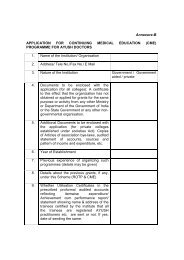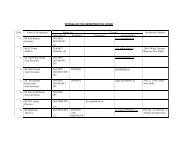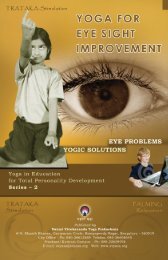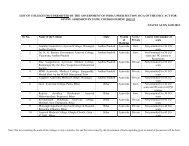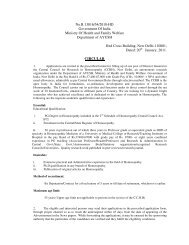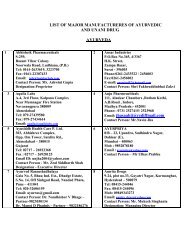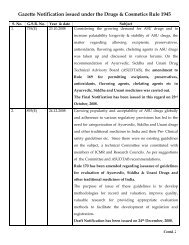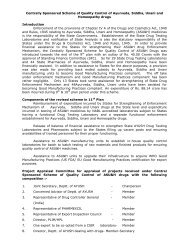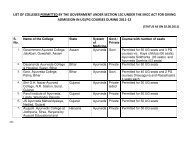Ayurvedic system of medicine is of great antiquity - Department of ...
Ayurvedic system of medicine is of great antiquity - Department of ...
Ayurvedic system of medicine is of great antiquity - Department of ...
Create successful ePaper yourself
Turn your PDF publications into a flip-book with our unique Google optimized e-Paper software.
AYUSH <strong>system</strong>s in the country. Presently,<br />
there are 3371 hospitals with about 66272<br />
beds, 22014 d<strong>is</strong>pensaries, 7.55 lakhs doctors,<br />
485 educational institutions with adm<strong>is</strong>sion<br />
capacity <strong>of</strong> about 27265 UG students and 2402<br />
PG students and 9173 drug-manufacturing<br />
units under AYUSH <strong>system</strong>s. Under NRHM,<br />
AYUSH facilities have been co-located with 182<br />
D<strong>is</strong>trict hospitals, 1008 CHCs and 4161 PHCs.<br />
A. AYUSH SYSTEMS<br />
i) Ayurveda :<br />
Ayurveda <strong>is</strong> perhaps as old as our<br />
civilization. Th<strong>is</strong> “science <strong>of</strong> Life” (Ayu +Veda)<br />
takes an integrated view <strong>of</strong> the physical,<br />
mental, spiritual and social aspects <strong>of</strong> human<br />
beings, each impinging on the others. Ayurveda<br />
was referred to in the Vedas (Rigveda and<br />
Atharvveda) and around 1000 B.C. the<br />
knowledge <strong>of</strong> Ayurveda was comprehensively<br />
documented in Charak Samhita and Sushrutha<br />
Samhita. According to Ayurveda, health <strong>is</strong><br />
considered as a pre-requ<strong>is</strong>ite for achieving the<br />
goals <strong>of</strong> life - Dharmas, Arth, Kama and<br />
Moksha (Salvation) and all objects and living<br />
bodies are composed <strong>of</strong> five basic elements,<br />
the Pancha Mahabhootas, namely: Prithvi<br />
(earth), Jal (water), Agni (fire), Vayu (air) and<br />
Akash (ether). The philosophy <strong>of</strong> Ayurveda <strong>is</strong><br />
based on the fundamental harmony between<br />
universe and man, a healthy balance between<br />
macrocosm and the microcosm. Ayurveda<br />
believes in the theory <strong>of</strong> Tridosha: Vata (ether +<br />
air), Pitta (fire) and Kapha (earth + water).<br />
These three ‘Doshas’ are physiological entities<br />
in living beings. The mental characters <strong>of</strong> men<br />
are described by Satva, Rajas and Tamas.<br />
Ayurveda aims to keep these structural and<br />
functional entities in a state <strong>of</strong> equilibrium which<br />
signifies good health (Swastha). Any<br />
imbalance due to internal or external factors<br />
causes d<strong>is</strong>ease and the treatment cons<strong>is</strong>ts <strong>of</strong><br />
restoring the equilibrium through various<br />
techniques, procedures, regimen, diet and<br />
<strong>medicine</strong>.<br />
The treatment in the Ayurveda <strong>system</strong><br />
<strong>is</strong> hol<strong>is</strong>tic and individualized having two<br />
components; preventive and curative. The<br />
preventive aspect <strong>of</strong> Ayurveda <strong>is</strong> called Svasth-<br />
Vritt and includes personal hygiene, regular<br />
daily and seasonal regimen, appropriate social<br />
behaviour and Rasayana Sevana, i.e., use <strong>of</strong><br />
rejuvenative materials/food and rasayana<br />
drugs. The curative treatment cons<strong>is</strong>ts <strong>of</strong> three<br />
major categories <strong>of</strong> procedures,<br />
Aushadhi(drugs), Anna(diet) and Vihara<br />
2<br />
(exerc<strong>is</strong>es and general mode <strong>of</strong> life). Ayurveda<br />
largely uses plants as raw materials for the<br />
manufacture <strong>of</strong> drugs, though materials <strong>of</strong><br />
animal, marine origin, metals and minerals are<br />
also used. <strong>Ayurvedic</strong> <strong>medicine</strong>s are safe and<br />
have little or no known adverse side-effects.<br />
Ayurveda developed into eight d<strong>is</strong>tinct<br />
specialities, i.e., Kayachikitsa (Internal<br />
Medicine), Kaumar Bhritya (Pediatrics), Graha<br />
Chikitsa (Psychiatry), Shalakya (Eye and ENT),<br />
Shalya Tantra (Surgery), V<strong>is</strong>ha-Tantra<br />
(Toxicology), Rasayana (Geriatrics) and<br />
Vajikarna (Science <strong>of</strong> virility).<br />
During the last 50 years <strong>of</strong><br />
development in the teaching and training in<br />
Ayurveda, twenty two specialties have now<br />
been developed. These are Ayurveda Sidhanta<br />
(Fundamental Principles <strong>of</strong> Ayurveda),<br />
Ayurveda Samhita, Rachna Sharira (Anatomy),<br />
Kriya Sharira (Physiology), Dravya Guna<br />
Vigyan (Materia Medica and Pharmacology),<br />
Ras-Shashtra (Pharmaceuticals using minerals<br />
and metals), Bha<strong>is</strong>hajya Kalpana<br />
(Pharmaceuticals), Kaumar Bhritya - Bala<br />
Roga (Pediatrics), Prasuti -Tantra evum Stri<br />
Roga (Obstetrics and Gynaecology), Swasth-<br />
Vritta (Social and Preventive Medicine),<br />
Kayachikt<strong>is</strong>a (Internal Medicine), Rog Nidan<br />
avum Vikriti Vigyan (Pathology), Shalya Tantra<br />
(Samanya)(Surgery), Salya Tantra – Kshar<br />
Karma avum Anushastra Karma (Kshars Karma<br />
and Para-surgical procedure), Shalakya Tantra<br />
-Netra Roga, Shalakya Tantra – Shiro-Nasa-<br />
Karna Avum Kantha Roga (ENT), Shalakya<br />
Tantra – Danta Avum Mukha Roga (Dent<strong>is</strong>try),<br />
Manovigyana avum Manas Roga (Psychiatry),<br />
Panchakarma, Agad Tantra avum Vidhi<br />
Vaidyaka (Toxicology and Jur<strong>is</strong>prudence),<br />
Sangyaharana (Anaesthesiology) and Chhaya<br />
avum Vikiran Vigyan (Radiology).<br />
Ayurveda provides a host <strong>of</strong> treatments<br />
for complex d<strong>is</strong>eases, and the traditional and<br />
time-tested <strong>system</strong>s <strong>of</strong> Ayurveda for hol<strong>is</strong>tic<br />
healing are available around the country.<br />
During recent years, Kshar Sutra and<br />
Panchkarma have become popular among the<br />
public. Panchakarma <strong>is</strong> a unique therapeutic<br />
procedure for the radical elimination <strong>of</strong> d<strong>is</strong>easecausing-factors<br />
and to maintain the equilibrium<br />
<strong>of</strong> doshas. The Panchakarma therapy reduces<br />
the chances <strong>of</strong> recurrence <strong>of</strong> the d<strong>is</strong>ease and<br />
promotes positive health by rejuvenating the<br />
vital body <strong>system</strong>s. Kshar Sutra <strong>is</strong> an <strong>Ayurvedic</strong><br />
para-surgical intervention using a medicated<br />
thread, which <strong>is</strong> extremely effective in the<br />
treatment <strong>of</strong> f<strong>is</strong>tula-in-ano and conditions which




